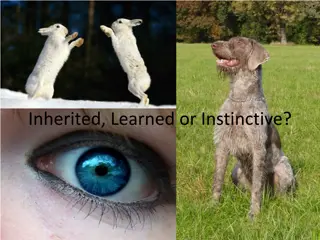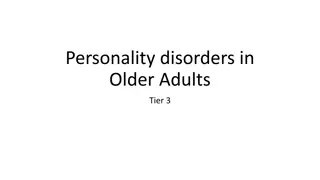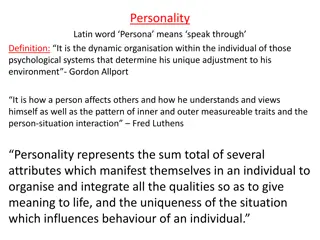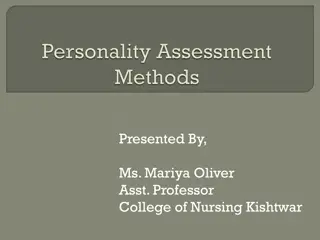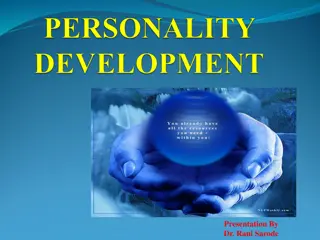Understanding Personality Traits and Assessments
Psychologists utilize traits to describe personality, addressing common misunderstandings about introversion and exploring the strengths and weaknesses of personality inventories. The consistency of personality traits over time and across situations is examined, along with the identification of insightful trait assessments. Limitations of trait classification and potential dimensions for individual categorization are also discussed, providing a comprehensive overview of trait theories in psychology.
Download Presentation

Please find below an Image/Link to download the presentation.
The content on the website is provided AS IS for your information and personal use only. It may not be sold, licensed, or shared on other websites without obtaining consent from the author. Download presentation by click this link. If you encounter any issues during the download, it is possible that the publisher has removed the file from their server.
E N D
Presentation Transcript
Learning Targets 57-1 Explain how psychologists use traits to describe personality. 57-2 Discuss some common misunderstandings about introversion. 57-3 Describe personality inventories, and discuss their strengths and weaknesses as trait assessment tools. 57-4 Identify the traits that seem to provide the most useful information about personality variation. 57-5 Discuss whether research supports the consistency of personality traits over time and across situations. Module 57 Trait Theories
How well do you know yourself? If asked, what would you say are your top ten personality traits? List them and share with a partner.
What is a trait? a characteristic pattern of behavior or a disposition to feel and act in certain ways, as assessed by self-report inventories and peer reports So, are you logical? Emotional? Solid? Unreliable? Hilarious? Moody?
1. What Would You Answer? Which of the following is the best term or phrase for a characteristic pattern of behavior or a disposition to feel and act? A. Myers-Briggs indicator B. Factor analysis C. Introversion D. Extroversion E. Trait
How do psychologists use traits to describe personality? Trait theorists such as Gordon Allport, Isabelle Briggs- Myers and her mother Katherine Briggs were concerned less with explaining individual traits than with describing them. Tests designed to sort people into personality types, such as the Myers-Briggs Type Indicator (MBTI), have been used in business and career counseling, but may have outlived their validity.
What are the limitations of relying on traits to classify individuals? Classifying people as one or another distinct personality type fails to capture their full individuality. We are each a unique complex of multiple traits. Instead, by placing people on several trait dimensions simultaneously, psychologists can describe countless individual personality variations.
What are two possible dimensions on which to place people? British psychologists Hans Eysenck and Sybil Eysenck believed that we can reduce many of our normal individual variations to two dimensions: extraversion introversion and emotional stability instability.
How has the idea been tested? People in 35 countries around the world, from China to Uganda to Russia, have taken the Eysenck Personality Questionnaire. When their answers were analyzed, the extraversion and emotionality factors inevitably emerged as basic personality dimensions. (Eysenck, 1990, 1992)
What is introversion? For example, an introverted person may attend a party along with an extraverted person and have a great time. When the party is over, the introvert goes home and puts their feet up. The extravert wants to keep the party going!
What makes an extravert? Just because someone is successful, fun or talks a lot around others, don t assume they are extraverted. They may be an introvert that is using all of their energy toward that event later they will want to reduce the stimulation.
What is a personality inventory? an objective questionnaire (often with true-false or agree-disagree items) on which people respond to items designed to gauge a wide range of feelings and behaviors; used to assess selected personality traits The classic personality inventory is the Minnesota Multiphasic Personality Inventory (MMPI).
What is the Minnesota Multiphasic Personality Inventory (MMPI)? the most widely researched and clinically used of all objective personality tests The MMPI was originally developed to identify emotional disorders (still considered its most appropriate use), it is also used in employment situations to assess personality characteristics
How is the MMPI designed? Over 500 empirically derived self-report T/F questions such as Nothing in the newspaper interests me except the comics are asked. Answers are then compared to answers given by people diagnosed with depression, schizophrenia, antisocial personality disorder and other disorders. The more similar the respondents answers are to those clinically diagnosed, the more indication exists that the person may be suffering a disorder.
What is an empirically-derived test? a test such as the Minnesota Multiphasic Personality Inventory (MMPI) created by selecting from a pool of items those that discriminate between groups Personality inventories are scored objectively. Objectivity does not, however, guarantee validity.
What are the scales on the MMPI? The researchers grouped the questions into 10 clinical scales, including scales that assess depressive tendencies, masculinity femininity (how rigidly one conforms to gender stereotypes), and introversion extraversion. Today s MMPI-2 has additional scales that assess work attitudes, family problems, and anger.
Which traits provide useful information about personality variation? Today s trait researchers believe that simple trait factors, such as the Eysencks introversion extraversion and stability instability dimensions, are important, but they do not tell the whole story. A slightly expanded set of factors developed by Robert McCrae and Paul Costa dubbed the Big Five does a better job. (Costa & McCrae, 2011)
What are the Big Five personality factors? Around the world-across 56 nations and 29 languages in one study-people describe others in terms roughly consistent with this list. (Schmitt et al., 2007)
What is conscientiousness? Highly conscientious individuals tend to be highly organized with great attention to detail. They are also goal-oriented and driven to succeed.
What is agreeableness? People high in agreeableness are cooperative, empathetic and caring. They enjoy helping and being part of a group.
What is neuroticism? People high in neuroticism experience mood swings and are often irritable. They worry about many things and get upset and anxious easily.
What is openness? People high in openness are creative and adventurous. They enjoy trying new things and taking on new challenges.
What is extraversion? People high in extraversion are outgoing and gain energy from being with others. They like to meet new people, start conversations and have a wide variety of friendships.
Where do you fall? Write down your scores on the 10 questions above.
Now score yourself Consider your results. How well do they align with how you see yourself?
Thinking critically. Before trying the self-assessment where would you have placed yourself on the Big Five personality dimensions? Where might your family and friends place you? Did the actual results surprise you, and do you think these results would surprise them? Share with your partner.
2. What Would You Answer? Jayne refuses to cheat on an exam that many of her friends have shown her copies of. Jayne would rank high on the Big Five trait of A. conscientiousness. B. agreeableness. C. openness. D. extraversion. E. neuroticism.
Are personality traits consistent over time? In some ways, our personality seems stable. Cheerful, friendly children tend to become cheerful, friendly adults. But it s also true that a fun-loving jokester can suddenly turn serious and respectful at a job interview. New situations and major life events can shift the personality traits we express.
What is the person-situation controversy? Our behavior is influenced by the interaction of our inner disposition with our environment. Still, the question lingers: Which is more important? When we explore this person-situation controversy, we look for genuine personality traits that persist over time and across situations. Are some people dependably conscientious and others unreliable, some cheerful and others dour, some friendly and outgoing and others shy? If we are to consider friendliness a trait, friendly people must act friendly at different times and places. Do they?
Is personality stable? With age, personality traits become more stable, as reflected in the stronger correlation of trait scores with follow-up scores 7 years later. (Data from Roberts & DelVecchio, 2000.)
Do traits = behaviors? Although our personality traits may be both stable and strong, the consistency of our specific behaviors from one situation to the next is another matter.
When do environments limit or encourage expression of traits? In unfamiliar, formal situations perhaps as a guest in the home of a person from another culture our traits remain hidden as we carefully attend to social cues. In familiar, informal situations just hanging out with friends we feel less constrained, allowing our traits to emerge. (Buss, 1989)
How does the research apply to you? How do think your own personality traits shine through in your music preferences, communication style, online presence and personal spaces? Can you recall a recent time in which the situation you were in definitely constrained your usual behavior? Share with a classmate.
Learning Target 57-1 Review Explain how psychologists use traits to describe personality. Trait theorists see personality as a stable and enduring pattern of behavior. They have been more interested in trying to describe our differences than in explaining them. Using factor analysis, they identify clusters of behavior tendencies that occur together. Genetic predispositions influence many traits.
Learning Target 57-2 Review Discuss some common misunderstandings about introversion. Western cultures prize extraversion, but introverts have different, equally important skills. Introversion does not equal shyness, and extraverts don t always outperform introverts as leaders or in sales success. Introverts often experience great achievement; many introverts prosper.
Learning Target 57-3 Review Describe personality inventories, and discuss their strengths and weaknesses as trait assessment tools. Personality inventories (such as the MMPI) are questionnaires on which people respond to items designed to gauge a wide range of feelings and behaviors. Test items are empirically derived, and the tests are objectively scored. But people can fake their answers to create a good impression; objectivity does not guarantee validity.
Learning Target 57-4 Review Identify the traits that seem to provide the most useful information about personality variation. The Big Five personality factors conscientiousness, agreeableness, neuroticism, openness, and extraversion (CANOE) currently offer the clearest picture of personality. These factors are stable and appear to be found in all cultures. Many genes, each having small effects, combine to influence our traits, and heritability generally runs about 40 percent for each dimension.
Learning Target 57-5 Review Discuss whether research supports the consistency of personality traits over time and across situations. A person s average traits persist over time and are predictable over many different situations. But traits cannot predict behavior in any one particular situation.








